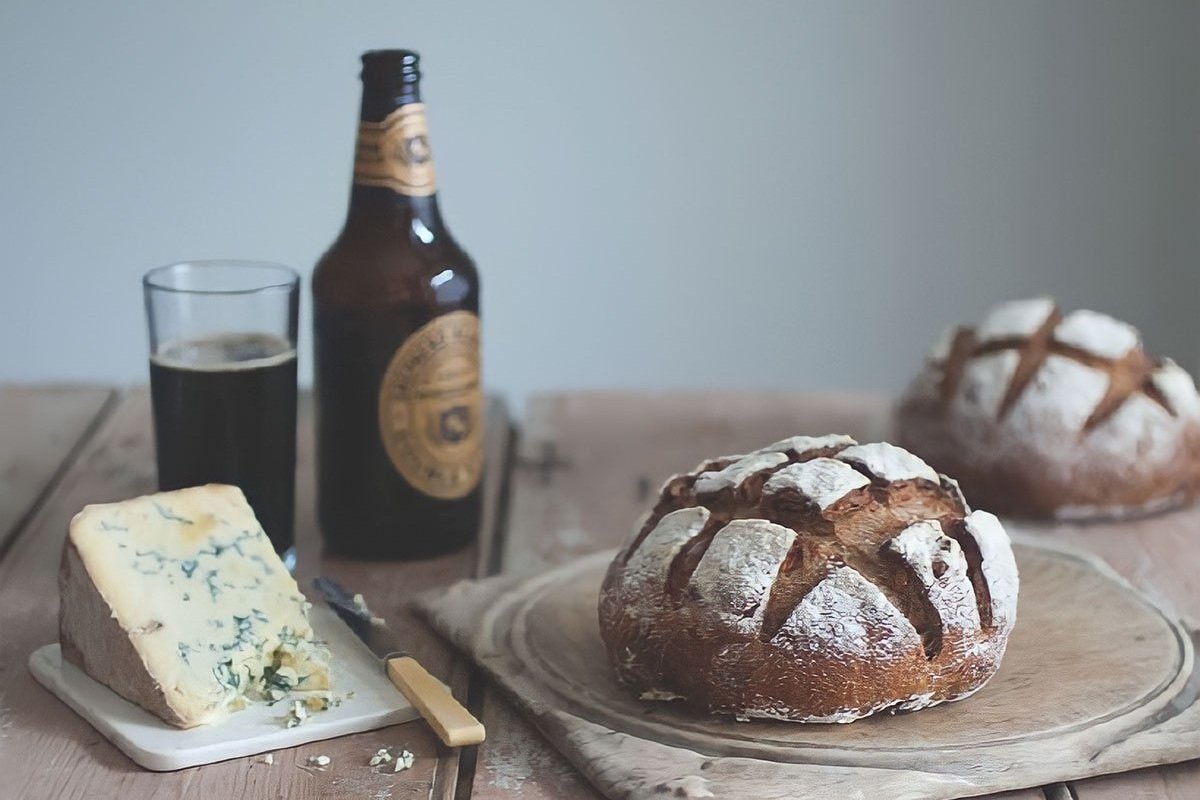Advertisement
Consuming Passions: Wild Garlic
2 May 2023 · Consuming passions
Di Murrell is a British food writer and food historian who has written extensively on food-related aspects of the waterways of Britain and France. Following her earlier celebration of sardines, in this piece she shares her love of wild garlic (along with other foraged woodland items). Commonly known in the US as ramps or ramsons, wild garlic is easy to find, growing abundantly in damp and shady woodland areas, and has a huge range of culinary uses. The wild garlic season runs from March until May or early June, so don’t miss your chance to forage some…
By Di Murrell

The Urban Forager
Early April, a chilly day with a blustery wind. I want to stay indoors. It’s probably going to rain and there’s not a lot to draw me out, nothing particularly rousing either in my line of sight: just a row of houses, some parked cars and a few small leafless trees dotting the pavement at irregular intervals. These last allow this very suburban street, part of a 1930’s ‘homes for heroes’ Waites Estate, the fancy designation of ‘avenue’. I change my mind - perhaps I will take a quick walk through the park and call in at the parade of shops on the other side for a newspaper and some milk.
Our park has a small river running through it - it’s a minor tributary of the Thames, and though it’s hemmed in on all sides by urban development, straightened and straitened, somehow nature hangs in there, providing a small linear frondescence along its banks and each year around this time, in early spring, manages to push new life up through the cold soil with the promise that once again everything will be alright.
Leaving the conventional tarmacked track where the dog-walkers, runners and cyclists convene, I cut along down beside an old backwater - a stream that used to serve a small watermill. Nothing left to see today other than a skeleton of sluices that once directed the waters to the wheel that powered the mill. Long gone; now there’s just the stream and a muddy path beside it, rarely trod; it is here that wild things grow.
The river bank is covered with starry celandines and though the bluebells have yet to flower, their strappy leaves are everywhere, serving as promissory notes of good things to come. The stingers have already begun to re-establish themselves, though right now they are young and fresh, their nip no more than a slight tingle on the fingers. Perfect for a nettle soup, I think. Ground elder, the bane of so many gardeners’ lives, is everywhere here too with leaves barely unfurled, this is the moment to harvest them - blanched, seasoned and doused in butter they make a fresh green side-dish to both meat and fish.
I stroll on, noting the catkins that dance in the wake of the slight breeze and the soft shade of yellowy green that willows wear at this time of year. The urban wildlife of squirrels, pigeons, ducks and moorhens are a little unsettled by my passing: they are not used to human intruders in this, their patch of the park. I press on, keeping my eyes open for signs of other weeds that might add interest to my table, though it’s not my sight but my nose that alerts me to my next find. Sadly, not quite the scent of truffles (hardly likely in a suburban park), but another equally distinctive whiff - that of wild garlic. There’s a dense, long-established patch here that runs right down to the water’s edge; damp and shady is where it grows best. New leaves are pushing up through the carpet of celandines, their white flowers gradually supplanting the gold.
I gather the leaves carefully and note that I am the only picker — no-one has been here before me. Today, I take just enough to conjure up a little pesto to top our lunchtime bowl of minestrone and I’m already planning a variation on Irish champ - chopped garlic leaves along with scallions and loads of butter mashed into tasty Charlotte potatoes - to have with a lamb chop for dinner tonight.
My path ends close to a belt of brambles and some gnarled old elders. My thoughts immediately turn to elderflower jelly, blackberry cordial and elderberry wine - all are grist to my forager’s mill. I’ll be back later in the year. As I leave the river bank and emerge into the wider parkland I see several clumps of chives pushing up through the grass. Adding a handful to my bulging bag, I make my way back into the domain of walkers and cyclists and mums with their baby buggies.
I shall be back in a day or two to gather more of the urban wild…
Preserving wild garlic
The wild garlic season is short, so it is worth finding ways to extend its culinary life. I find it lasts very well if simply washed and gently dried. Use kitchen roll or wrap and pat dry in a clean tea towel. Then chop small in a food processor, binding with a little light flavoured olive oil. Pack into sterilised jars making sure that there is a slick of oil covering the surface. If you are using it, once opened, it keeps well in the fridge for 3 weeks or so. Other jars will keep indefinitely in the freezer
There are several other ways to preserve the leaves. Make wild garlic salt by drying the leaves in a really low oven (80-100C, leaving the door ajar). For this you’ll need about a carrier bag full of leaves without stalks that have been washed and dried. Spread them out on the oven shelves with a baking tray at the bottom to catch any flaky bits. It takes about an hour to dry them in a fan oven, but check periodically, and remove once they are bone dry, spreading out any others that are still a bit limp. Once they are all dry, blitz them with a sprinkling of sea salt in a processor or grind using a pestle and mortar until reduced to a powder. Store in an airtight container and use to add a delicious wild garlic zing whenever you need it.
One can pickle the flowers while they are still in bud or wait until they have gone to seed and use them like a garlicky caper to make a tartare sauce or flavour sauces. Gather the flower buds, or the seeds when they are large and green. Wash them, removing any stalks. Drain in a sieve and dry with a tea towel. Heat some white wine or cider vinegar in a pan until boiling, throw in the buds/seeds and bring back to the boil. Remove from the heat and allow to cool for a couple of minutes. Pour into sterilised jars. Once cool, tighten the lids on the jars.
A wild garlic oil is easily made by chopping a big bunch of leaves and packing it tightly into a jar or bottle. Cover with olive oil and leave to infuse for a week or two. Then strain through muslin to remove the chopped leaves (if you want to). It will keep well in the fridge for about a month.
Finally, wild garlic butter - especially good stirred through pasta or mashed potato though it has any number of other uses. Soften 500g of salted butter in a microwave for 10-15 seconds. Chop handfuls of washed, dried leaves very finely and work it into the butter until evenly distributed. Spoon onto clingfilm and roll it up tightly to make a sausage shape, twisting the ends. Refrigerate until ready to use or store in the freezer.
Tips for foragers
There are so many simple and interesting ways to add foraged foods to one’s diet. And particularly soul-satisfying when you have found them for yourself. The cost is minuscule, healthy and fun too. It is definitely worth reading up on the edible plants one can find before starting the search, be able to recognise whatever you are looking for and thus pick with confidence.
When picking wild garlic (or ramsons as they are sometimes called), don’t be tempted to simply grab a bunch and run; picking the leaves individually takes little time. Cut the stems close to the ground and place them gently in a foraging basket or bag in an orderly fashion. This bit of extra effort comes in handy, especially when it is time to wash them. Never harvest more than a third of what you find. Take only what you need and leave plenty for nature and other insects and animals. Try not to pull up the bulbs, unless you are transplanting them. While they are edible, it is best to leave the bulb in the ground, so that the plant can recover and remain productive from season to season.
Even after more than 30 years, Roger Phillips’ Wild Food: A Complete Guide for Foragers is still the definitive guide to all things wild and edible, with great illustrations to aid identification—and a recipe for ground elder!
For a full description of the plant and its uses, refer to the wild garlic entry in the eternally useful Oxford Companion to Food by Alan Davidson. And finally, don’t forget to check-out ckbk’s own selection of 12 Wild Garlic Recipes (below).
More Consuming Passions
Joy Skipper on the process that leads from bean to bar, and the hedonistic pleasures of cooking with chocolate
Drinks writer Laura Hadland on the darkest and most intensely flavored of beer styles, with countless culinary uses
Omani food writer Dina Macki, known as The Pomegranate Queen on Instagram, celebrates her favorite fruit
Sign up for ckbk's weekly email newsletter
Advertisement








